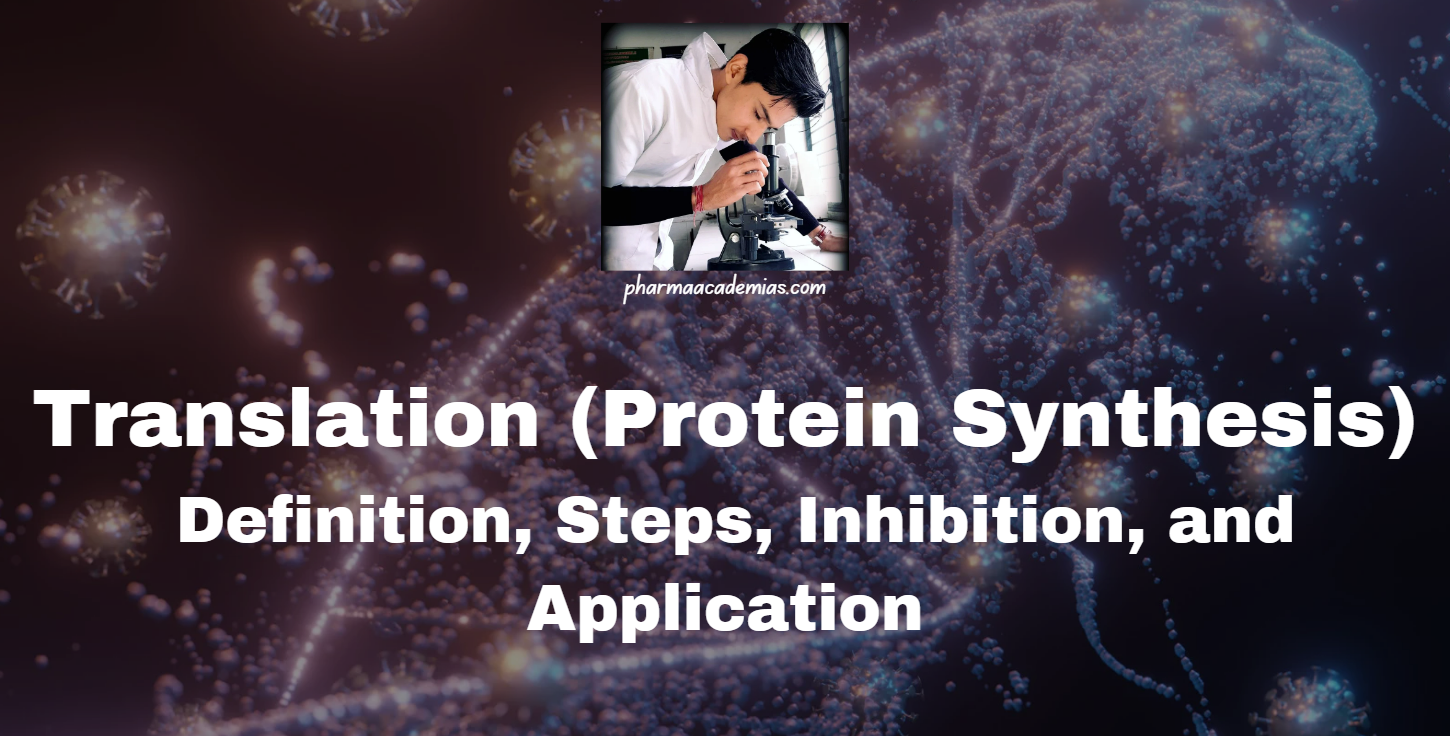Translation is the process by which the genetic code carried by messenger RNA (mRNA) is decoded to produce a specific sequence of amino acids in a polypeptide chain, which folds into a functional protein. This process occurs in the cytoplasm of both prokaryotic and eukaryotic cells and involves ribosomes, transfer RNA (tRNA), and various enzymatic factors.

Steps of Translation
1. Initiation:
mRNA Binding: The small ribosomal subunit binds to the mRNA near the 5′ cap in eukaryotes or the Shine-Dalgarno sequence in prokaryotes.
Start Codon Recognition: The ribosome scans the mRNA until it finds the start codon (AUG), which codes for methionine.
Initiator tRNA: The initiator tRNA carrying methionine binds to the start codon. This tRNA is called tRNA^Met in eukaryotes and tRNA^fMet in prokaryotes.
Large Subunit Binding: The large ribosomal subunit joins the complex, forming the complete ribosome with the initiator tRNA positioned in the P (peptidyl) site.
2. Elongation:
Aminoacyl-tRNA Entry: A charged tRNA carrying the next amino acid binds to the codon in the A (aminoacyl) site of the ribosome.
Peptide Bond Formation: The ribosome catalyzes the formation of a peptide bond between the amino acid in the A site and the growing polypeptide chain in the P site.
Translocation: The ribosome moves along the mRNA by one codon, shifting the tRNA in the A site to the P site and the tRNA in the P site to the E (exit) site. The empty tRNA is then released from the E site.

3. Termination:
Stop Codon Recognition: When a stop codon (UAA, UAG, or UGA) is encountered in the A site, translation terminates.
Release Factors: Release factors bind to the stop codon, prompting the release of the polypeptide chain from the tRNA in the P site.
Ribosome Disassembly: The ribosomal subunits, mRNA, and tRNA dissociate, ready to be used for another round of translation.
4. Post-Translational Modifications:
Folding: The newly synthesized polypeptide folds into its three-dimensional structure, often with the assistance of chaperone proteins.
Modifications: The polypeptide may undergo various modifications, such as phosphorylation, glycosylation, or cleavage, to become a functional protein.
Inhibitors of Translation
Inhibitors of translation are molecules that interfere with the process of protein synthesis. These inhibitors can target different stages of translation and are often used as antibiotics, antiviral agents, or research tools.
1. Prokaryotic Translation Inhibitors:
Streptomycin: Binds to the 16S rRNA of the 30S ribosomal subunit, causing misreading of mRNA and inhibiting initiation.
Tetracyclines: Bind to the 30S subunit and block the attachment of aminoacyl-tRNA to the A site.
Chloramphenicol: Inhibits peptidyl transferase activity on the 50S ribosomal subunit, preventing peptide bond formation.
Erythromycin: Binds to the 23S rRNA of the 50S subunit, blocking the exit tunnel and preventing elongation.
Gentamicin and Kanamycin: Bind to the 30S subunit, causing misreading of mRNA.
2. Eukaryotic Translation Inhibitors:
Cycloheximide: Inhibits peptidyl transferase activity on the 60S ribosomal subunit, preventing elongation.
Diphtheria Toxin: Modifies elongation factor 2 (EF-2) by ADP-ribosylation, inhibiting translocation.
Ricin: Inactivates the 60S subunit by depurinating a specific adenine residue in the 28S rRNA, inhibiting protein synthesis.
3. Broad-Spectrum Inhibitors:
Puromycin: Mimics aminoacyl-tRNA and incorporates into the growing polypeptide chain, causing premature termination in both prokaryotes and eukaryotes.
Mechanisms of Action
Ribosome Binding: Many inhibitors function by binding to specific sites on the ribosome, preventing the binding of tRNA or mRNA, or inhibiting ribosomal movements.
Enzyme Inhibition: Some inhibitors target enzymes involved in translation, such as peptidyl transferase or elongation factors, blocking their activity.
mRNA Interference: Certain inhibitors bind directly to mRNA, preventing its proper interaction with the ribosome.
Clinical and Research Applications
Antibiotics: Many translation inhibitors are used as antibiotics to treat bacterial infections by specifically targeting bacterial ribosomes without affecting eukaryotic ribosomes.
Antiviral Agents: Some inhibitors are used to target viral protein synthesis, hindering viral replication.
Research Tools: Translation inhibitors are valuable in research to study the mechanisms of protein synthesis and the role of specific proteins in cellular processes.
Understanding the process of translation and the action of its inhibitors is crucial for developing new therapeutic strategies and antibiotics, as well as for advancing our knowledge of cellular biology and protein synthesis.
visit also: Pharmacareerinsider.com

